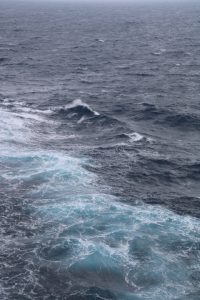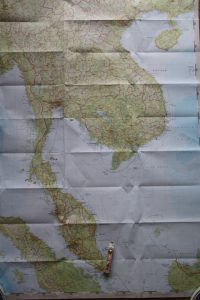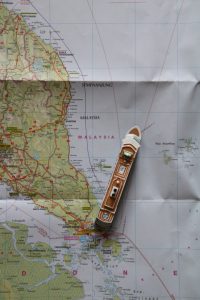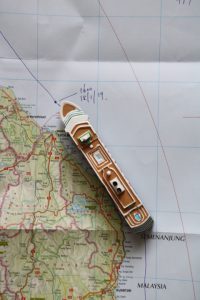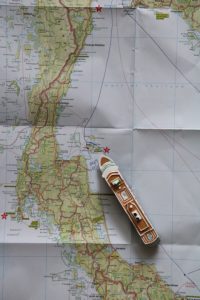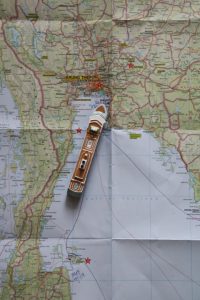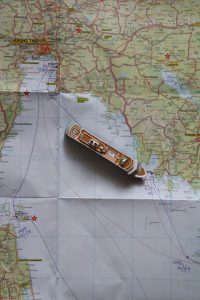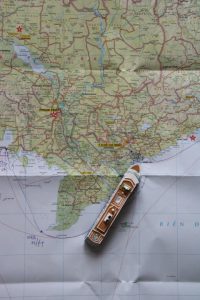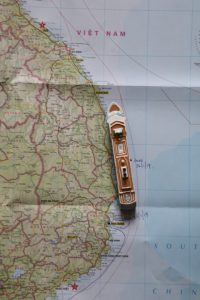Today we are at sea. At 10:00 a.m. we are at 110E and 13N in the South China Sea area of the Pacific Ocean as we head towards Hue. It is 25C with a force 5 wind from the northeast and the decks are wet from the humidity and spray from the ocean.
The steward dressed our towel friend for the weather this morning when he made up our room.
In the recently published book “The New Silk Roads” (Frankopan P. Bloomsbury 2018) the author describes the economic developments in recent times in this region. These include proposals for and investment in high speed freight lines connecting the deep-water ports of Cambodia, Vietnam and Thailand with their interiors and China. All of this and the so-called inland ‘dry-ports’ along the original silk and spice routes is yet again evidence of historical continuity. The past continues to be very important today. An example of this was the arrival in January 2017 in the UK of the first freight train from China along what is today known as ‘The Belt Link’ route across Central Asia. The ancient routes are certainly still operating here and continue to shape parts of the world connected to it. At the time of writing rising nationalism in the USA may prevent their participation in the dynamic future that these developments provide.
Our day at sea gives us an opportunity to study our route so far.
Marco Polo was the first European to cross the Mekong and in the centuries that followed it was France that claimed much of the region as a protectorate. This was a ploy to hide colonial expansion, but historians agree that this may have unified the area.
French military in Vietnam began in 1847 and Saigon was seized in 1859. Cambodia succumbed in 1864 and Bangkok in 1893. By now there was only Thailand holding on to its monarchy and some semblance of independence.
With the onset of WW2 and France’s capitulation in Europe, here they sided with the Japanese. Communism grew in strength as a means of promoting independence and fairer land distribution.
Between 1944 and 1945 the Viet Minh received funding from the USA via what was to become the CIA. This was seen as subversive by the French so that when Ho Chi Minh declared Vietnam to be independent on 2nd September 1945 the French had other ideas. Defeated in Europe they saw this as an opportunity to show their strength. This led to at least 30 years of warfare and civil unrest. In 1953 Cambodia and Laos achieved independence from France leaving the latter clinging on to power in Vietnam. The French surrendered to the Viet Minh on 7th May 1954 at Diên Bien Phu thus marking the end of colonial rule in Indonesia-China.
Vietnam was divided at 17N, into the communist north (Ho Chi Minh) and the ‘free’ south (Ngo Dinh Diem).
The Ho Chi Minh trail which existed during the time of the French reopened as the main supply route to the south. During the 1960s the USA sent in ‘advisors’ to promote a military coup because they saw Diem as a liability. Presidents Kennedy and Johnson turned the policy around and saw military force as the only way of resolving the conflict. At first it was done secretly but eventually this could not be kept and more and more US marines were sent to the country to avoid a communist victory. Through 1968 and 69 the US carpet bombed vast areas of the region, whole forests were defoliated using chemicals so that the enemy could be seen from the air and hundreds of thousands of people on all sides were killed.
In the eyes of historians this is seen as an American failure, but some of the veterans on board our ship have an opposing story to tell after meeting Vietnamese people who were grateful for what they did.
On 27th January 1973 a Peace Accord was signed in Paris. President Nixon saw this as the opportunity to ‘withdraw with honour’, but really it was a face saving deal which allowed the soldiers to leave but not in a particularly peaceful way and the last Americans being airlifted from the roof of their embassy in Saigon with threatening crowds at the gates.
Fighting continued between the nations of the region until 1991. Again, in Paris, accords were signed that led to free elections. All of this had a terrible cost – murder, destruction of families and persecution. Fortunately there has been a reversal of fortune and as we have seen earlier a return to former trading patterns.
